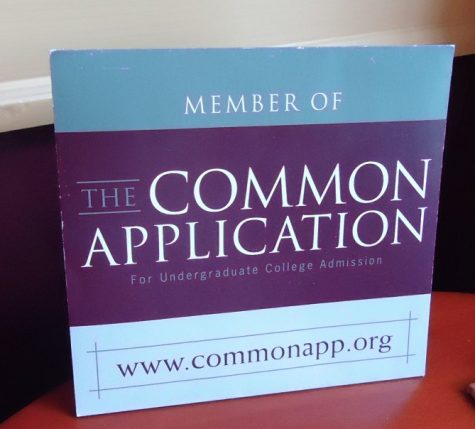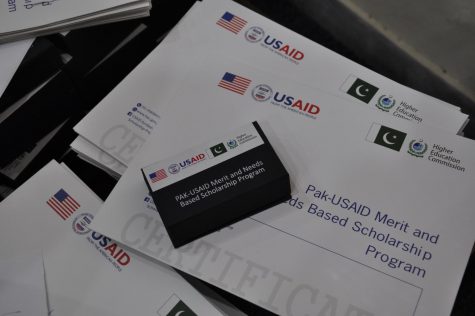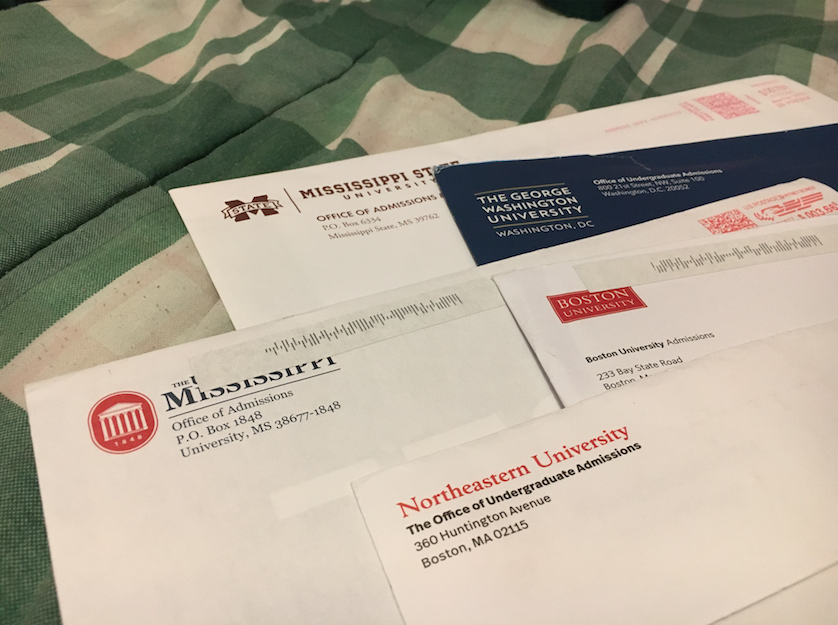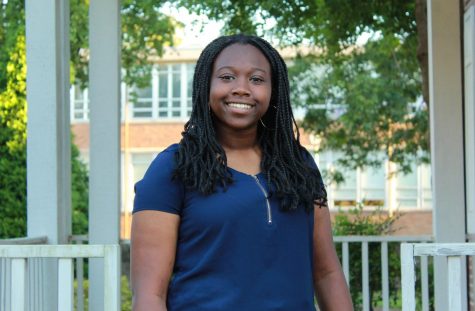Jira: The college application process–universally flawed and selectively rewarding
A look into a troubling process
As the college application process comes to an end for the class of 2020, they reflect back on the flaws of the process as the class of 2021 worries about the various stressors to come.
April 30, 2020
“What do you want to be when you grow up?”
It would be nearly impossible to find a child in America who hasn’t been asked this question. This question is usually followed up with a statement: you can be anything you want to be. In fact, that very statement is why I spent a solid year of my life convinced I was going to be the next “Thomas the Tank Engine.” But as we grow up and realize our locomotive dreams aren’t as viable as we once thought, we latch onto a different dream–the dream of going to college. Higher education unlocks a plethora of doors and is, in almost every situation, the key to future success. With this in mind, millions of Americans across this country set out to secure their futures by applying to college. And while for some students, especially MSMS students, this process has been extremely rewarding, we will tell you that the process is long, confusing, time-consuming, taxing, and in desperate need of reform.
Rising Selectivity
While the demand for higher education has boomed in recent decades, the acceptance rates, inversely, have taken a nosedive. In 1988, Columbia University accepted 65 percent of its applicants. In 2018, the university accepted just shy of a tenth of that number at 6.6 percent. This phenomenon isn’t limited to uber-selective Ivies either; the University of Michigan’s acceptance rate dropped from 52 percent to 33 percent between 1988 and 2014. So what’s to blame for the flood of rejection letters sent out each year?
For one, when colleges soothe your disappointment or, if you’re lucky, stroke your ego by saying “your applicant pool was one of the most competitive yet,” they’re not joking. Emphasis on primary and secondary education as well as a collective realization that a college degree increases your human capital has dramatically increased not just the number of college applicants but the number of good college applicants.

The Common Application is a portal which students can apply to various colleges at one time.
There are a host of other factors at play, such as the fact that students are applying to more schools, due in large part to things like the Common Application making it “easier” to apply to more schools. Additionally, globalization has widened the door for international students meaning in most cases you aren’t competing with just domestic applicants, but applicants from across the world as well.
So, as we can see, the issue of increasing college selectivity isn’t one that is caused by negative factors. We are smarter, we see the value in education, and we are opening the doors for applicants across the world. But for some high achieving students like all students at MSMS, college selectivity made the college application cross just that much harder to bear.
“Like most students, I have a grand fear of rejection that is also partnered with indirect peer pressure to go [to] an elite college. I had no 36 on the ACT or 4.0 GPA, and the pressure became this ball and chain I lugged around the entirety of the first semester,” said senior Binta Fadiga. “For a solid month, I stressed myself out to the point where I suffered from two to three migraines a week.”
Negative Toll on Mental Health
Migraines are not the only way that students are suffering due to the pressures of the current college application system in place. The college application process has become, as Victor Schwartz, chief medical officer at the Jed Foundation, puts it, a competition for academic achievement.
“The sense that success or failure are very high stakes has led to an intensifying of the competition to get into elite colleges…there is no room for error at all. If you get a B in seventh grade, there is a perception that your future is shot,” Schwartz told HuffPost. Though this is not the case, many students fail to realize this and push themselves to the limits in the name of a better future.
This kind of mindset forces you to look at yourself in numbers–is my ACT score high enough? Should I be taking more AP’s? Do I have enough leadership positions? You can’t help but feel like your life is defined by how close you are to a 4.0, 36 or 1600. Students overwork themselves to polish their resumes and transcripts. Some students are feeling this pressure before their college application season has even begun.
“I was hyper-focused for months on getting a 30 or above on the ACT because I knew it meant better scholarship opportunities,” said junior Felicity Browning. “When I finally reached it, I felt that it wasn’t enough and that there would always be someone with a higher test score. I’m not quite sure when I’ll finally believe I am good enough academically.”
It’s old news, now, that America is facing a crisis when it comes to the mental health of teens and preteens. Research conducted by the American Psychological Association’s Journal of Abnormal Psychology found that “Symptoms associated with major depression rose by 52 percent in adolescents ages 12 to 17.” While I have found no concrete scientific evidence linking this phenomenon to the increasing pressure higher education poses, you’d be hard pressed to convince me that there isn’t one.
“While I think the process only has as much power over you as you give it, I couldn’t help but to worry every day. I jeopardized so many relationships with people and opportunities to live normally just so I could do what I needed to look like an acceptance worthy student,” offered senior Cameron Thomas. “It just takes the fun out of doing extracurricular activities when you feel as if they are your main outlet to look like a standout student because your standardized test scores don’t reflect who you are as a student.”
There is also the fundamental pressure of feeling as though every decision you’re making throughout the entire process has the potential to affect the course of the rest of your life from that point forward. Juniors and seniors alike feel this pressure.
“Starting last week, a cloud of anxiety began to loom over me. With senior portfolios being due, I have really zoned in on the fact that I am about to make one of the biggest decisions of my life,” said junior Niyah Lockett. “Most days, I still feel like a child with all the time in the world to ‘grow up.’ As college application season approaches, I have come to realize that I am about to start the beginning of the rest of my life. All of these thoughts are very intimidating, but I am honestly excited for the journey ahead of me.”
Another senior anonymously shared similar feelings but in retrospect.
“It’s very stressful as a senior because you feel like your entire future is on the line (cause it kinda is) but you also have to keep up with school work and extracurriculars. Because of this, I was not getting enough sleep and not eating properly which really had a toll on my mental health.”
Expense with a Sprinkle of Exploitation
When considering the cost of college, most people’s minds focus on the cost of attendance. But the fact of the matter is that just applying to schools can be incredibly expensive for some students. Some schools charge upwards of $100 just to submit an application. This combined with a phenomenon that encourages application to as many schools as possible, and the cost can add up pretty quickly. Some MSMS students reported spending between $400 and $500 on college applications alone.
Students who qualify for free/reduced lunch are eligible for fee waivers that diminish the overall cost of attending college, but that is not the case for all students.

Students can only hope for really competitive scholarships to afford college expenses.
“I most definitely had to sacrifice a lot to just apply to these colleges. I don’t really qualify for the fee waivers, yet my mom was the only one paying the fees. Let’s just say that Christmas and my birthday were really light in money/gifts this year. My mom also had to take on another job even though she works full time as a teacher,” Thomas said.
Other students found that the line had to be drawn based on those application fees alone, as senior Ada Fulgham expressed. “I got very optimistic and excited about applying to colleges…I was so into applying to all the amazing art colleges I’d had in mind to go to for years. After realizing how much money it cost to simply apply, though, I got super depressed because many of the colleges I was looking at had application fees of $70 or more. So I had to reevaluate what was within reason for me and only applied to a few.”
As one quickly discovers when applying to college, the money doesn’t stop at the application fees. Schools that aren’t test-optional require students to submit an ACT or SAT score, both of which most students sit multiple times in search of their desired score. Other tests that cost money such as subject area tests (offered by the College Board) and AP exams (offered by the College Board) are not required by most schools, but, provided you do well on them, can increase your chances of acceptance and count towards college credits upon your enrollment. Other services, such as the CSS profile (offered by the College Board) are required by some schools to be eligible for financial aid.
No doubt, you’ve figured out where I’m going with this. Sometimes it feels impossible to get away from the College Board when you’re applying to schools, especially private ones. Despite their revenue being upwards of $850 million a year, they’re still considered nonprofit. No one likes the College Board and with good reason. They’ve made moves in recent years that make everyone question just how nonprofit they really are, such as shifting the payment date for exams to earlier in the school year, so students have less time to decide if they want to take the exams/request refunds if they decide otherwise.
Fadiga, like most students, does not view the College Board with much favor.
“College Board and the ACT only heightens any socio-economic barriers one may have. Any academically talented student can perform well on these tests, with the right kind of preparation that is generally only accessible to students who can afford it.”
And she is correct. Assuming you meet the requirements for all of these fees to be waived, there are a host of materials–like prep books provided by the College Board–that, while advantageous, are optional and pose an additional fee. If you don’t qualify for your fees to be waived, yet aren’t rich enough to take lightly the kind of money applying to college can require, then you find really feeling the monetary burden before you’ve even been accepted anywhere, as students above expressed.
It’s Not Fair
When the college admissions scandal rocked the nation, everyone was shocked by the revelations that were made. Big-name actresses like Felicity Huffman and Lori Loughlin cheated to get their children into prestigious schools. While this example is a bit more extreme because it was, well, criminal, it speaks to the ever-present fact that upward mobility will always be easier for those with money.
College application fees can pose a burden, yes, but there are a host of other less direct challenges that low-income students must face. For example, low-income students are more likely to attend low-income schools where access to resources and information isn’t as readily available. For example, before attending MSMS, I had never heard the terms “Common Application,” “FAFSA,” “Fee Waiver” or “Questbridge.” In addition, students at these schools may not have access to classes that prepare them for college intellectually or competitively, like AP courses. The list doesn’t end there.
The college application, though rewarding, is one that is extremely tedious. At MSMS, we are lucky to have counselors whose main function is to assist us in applying to college, teachers who know us personally and are willing to edit our essays and write us recommendation letters, and peers to support us as they go through the process with us. Having none of this and knowing nothing of programs that are meant to help low-income students, those students can find themselves trapped before they’ve even begun. Other barriers, like being a first-generation student also pose challenges like senior Ryley Fallon expressed.
“As a first-generation student, it was very challenging to sort out all the fine print,” she said. “I really had to rely on my counselors and my willingness to call the admissions offices every time I had a question. The financial aid part is worse than just the general application. The amount of information needed is more than I could have ever imagined.”
Fallon points out another problem–the Common Application has streamlined (for the most part) the process of applying to multiple schools. But applying for financial aid, as Fallon stressed, is worlds worse than the general application. Different schools require different materials to be uploaded into a series of different portals. Navigating this terrain without help from a counselor, teacher, or parent makes not only getting into college but paying for college more of a mirage than ever before.
Tomorrow, May 1, is decision day. Students all across the country will boast college merch and bright smiles before updating their Instagram biographies to include their future alma maters because at the end of the day, I think we all realize that no matter what, this process was extremely rewarding. Whether you are going to one of these schools or one of these schools, the fact that you are receiving higher education at all is amazing–you’ve opened doors for yourself that likely would have remained firmly shut otherwise. But despite all of this, there is no doubt that this system needs revision. There are too many that fall in between the cracks–to whom May 1 is just another day because, despite their best efforts, this system is one that stands firmly against their favor. Even for those of us who are going to college in the fall, the price shouldn’t be years of hyper fixation on numbers and eroding mental health.
Life isn’t fair. People love to say that, and while it may be true, it is not an excuse for us to ignore the inherent inequities in this system that could be solved to make this system one that is more safe and equitable for everyone.











